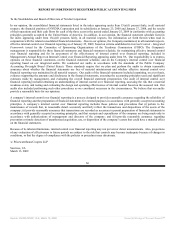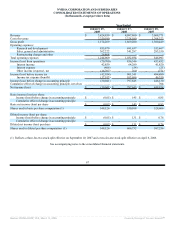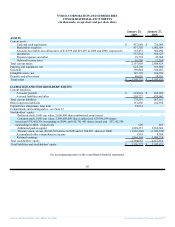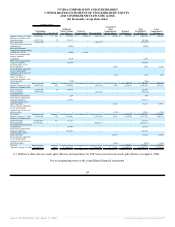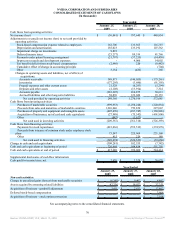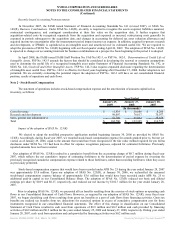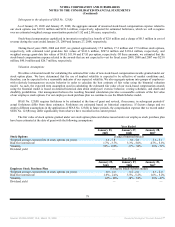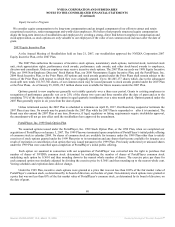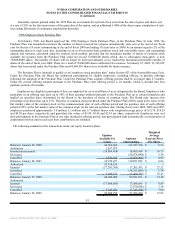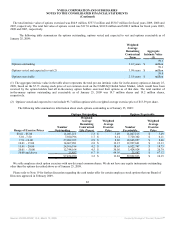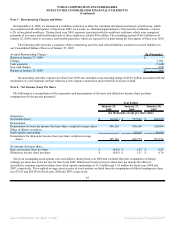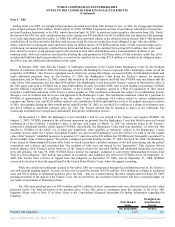NVIDIA 2009 Annual Report Download - page 90
Download and view the complete annual report
Please find page 90 of the 2009 NVIDIA annual report below. You can navigate through the pages in the report by either clicking on the pages listed below, or by using the keyword search tool below to find specific information within the annual report.
NVIDIA CORPORATION AND SUBSIDIARIES
NOTES TO THE CONSOLIDATED FINANCIAL STATEMENTS
(Continued)
Marketable Securities
We account for our investment instruments in accordance with Statement of Financial Accounting Standards No. 115, or SFAS
No. 115, Accounting for Certain Investments in Debt and Equity Securities. All of our cash equivalents and marketable securities are
treated as “available-for-sale” under SFAS No. 115. Cash equivalents consist of financial instruments which are readily convertible
into cash and have original maturities of three months or less at the time of acquisition. Marketable securities consist primarily of
highly liquid investments with a maturity of greater than three months when purchased. We classify our marketable securities at the
date of acquisition in the available-for-sale category as our intention is to convert them into cash for operations. These securities are
reported at fair value with the related unrealized gains and losses included in accumulated other comprehensive income (loss), a
component of stockholders’ equity, net of tax. Any unrealized losses which are considered to be other-than-temporary impairments
are recorded in the other income (expense) section of our consolidated statements of operations. Realized gains (losses) on the sale of
marketable securities are determined using the specific-identification method and recorded in the other income (expense) section of
our consolidated statements of operations.
All of our available-for-sale investments are subject to a periodic impairment review. Investments are considered to be
impaired when a decline in fair value is judged to be other-than-temporary when the resulting fair value is significantly below cost
basis and/or the significant decline has lasted for an extended period of time. The evaluation that we use to determine whether a
marketable security is impaired is based on the specific facts and circumstances present at the time of assessment, which include the
consideration of general market conditions, the duration and extent to which fair value is below cost, and our intent and ability to hold
an investment for a sufficient period of time to allow for recovery in value. We also consider specific adverse conditions related to the
financial health of and business outlook for an investee, including industry and sector performance, changes in technology, operational
and financing cash flow factors, and changes in an investee’s credit rating. Investments that we identify as having an indicator of
impairment are subject to further analysis to determine if the investment is other than temporarily impaired, in which case we write
down the investment to its estimated fair value.
Fair Value of Financial Instruments
The carrying value of cash, cash equivalents, accounts receivable, accounts payable and accrued liabilities approximate their
fair values due to their relatively short maturities as of January 25, 2009 and January 27, 2008. Marketable securities are comprised of
available-for-sale securities that are reported at fair value with the related unrealized gains and losses included in accumulated other
comprehensive income (loss), a component of stockholders’ equity, net of tax. Fair value of the marketable securities is determined
based on quoted market prices.
Concentration of Credit Risk
Financial instruments that potentially subject us to concentrations of credit risk consist primarily of cash equivalents,
marketable securities and accounts receivable. Our investment policy requires the purchase of top-tier investment grade securities, the
diversification of asset type and includes certain limits on our portfolio duration. All marketable securities are held in our name,
managed by several investment managers and held by one major financial institution under a custodial arrangement. Accounts
receivable from significant customers, those representing 10% or more of total accounts receivable aggregated approximately 38% of
our accounts receivable balance from three customers at January 25, 2009 and approximately 12% of our accounts receivable balance
from one customer at January 27, 2008. We perform ongoing credit evaluations of our customers’ financial condition and maintain an
allowance for potential credit losses. This allowance consists of an amount identified for specific customers and an amount based on
overall estimated exposure. Our overall estimated exposure excludes amounts covered by credit insurance and letters of credit.
Accounts Receivable
We maintain an allowance for doubtful accounts receivable for estimated losses resulting from the inability of our customers to
make required payments. We determine this allowance, which consists of an amount identified for specific customer issues as well as
an amount based on overall estimated exposure. Factors impacting the allowance include the level of gross receivables, the financial
condition of our customers and the extent to which balances are covered by credit insurance or letters of credit.
75
Source: NVIDIA CORP, 10-K, March 13, 2009 Powered by Morningstar® Document Research℠


